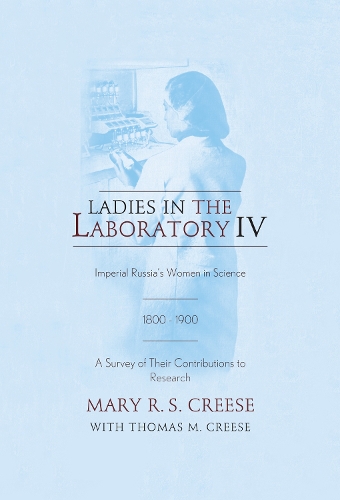
Ladies in the Laboratory IV: Imperial Russia's Women in Science, 1800-1900: A Survey of Their Contributions to Research
(Hardback)
Publishing Details
Ladies in the Laboratory IV: Imperial Russia's Women in Science, 1800-1900: A Survey of Their Contributions to Research
By (Author) Mary R. S. Creese
With Thomas M. Creese
Bloomsbury Publishing PLC
Rowman & Littlefield Publishers
12th March 2015
United States
Classifications
Professional and Scholarly
Non Fiction
Gender studies: women and girls
Reference works
500.820947
Physical Properties
Hardback
188
Width 218mm, Height 287mm, Spine 18mm
762g
Description
The first volume of Ladies in the Laboratory provided a systematic survey and comparison of the work of nineteenth-century American and British women in scientific research. Companion volumes focused on women scientists from Western Europe and the former British colonial territories of South Africa, Australia, New Zealand, and Canada. In Ladies in the Laboratory IV, Mary R.S. Creese expands her scope to include the contributions of nineteenth-century women of Imperial Russia. Many of these women believed that science was the key to social progress, and the great advances in scientific researchwork in which Russians had leading rolesmade scientific training especially attractive. Featuring biographical sketches of more than 120 women, this volume covers individuals whose scientific research encompassed medicine, chemistry, zoology, botany, and paleontology. Organized into chapters by field, the entries provide details about the personal backgrounds as well as professional achievements of these remarkable women. A well-organized blend of individual life stories and quantitative information, this volume is for everyone interested in nineteenth-century science. The stories of these women make for fascinating reading and serve as a valuable source for those who want to learn more about the history of women in science and medicine as well as nineteenth-century Russian history.
Reviews
This well-documented book, the fourth in a series describing the life and scientific accomplishments of 19th-century women, focuses on Russia. A former research chemist, Creese describes how women used science to advance themselves as independent thinkers. The interesting stories in the book show the variety of paths taken to achieve mastery of science. Politics in 19th-century Imperial Russia were different from politics in Europe or America, and this was reflected in the societal position of women. For some, science was seen as a means to advance gender equality using nihilist, communist ideals; others were born to Russian parents but had European family ties that influenced their scientific pursuits. Creese notes that at the end of the 19th century, over 50 percent of scientific articles published by Russian women were in medicine, followed by chemistry. Medical studies were carried out mainly in Switzerland, and many women on their return to Russia cared for the poor, women, and children in rural areas. However, some remained in Europe orimmigrated to the United States, where they promoted womens higher medical education. All in all, this book provides readers with a good blend of life stories and quantitative information. Summing Up: Recommended. Upper-division undergraduates through professionals and practitioners. * CHOICE *
Author Bio
Mary R.S. Creese is a former research chemist and has written numerous publications about the history of women scientists. She is the author of Ladies in the Laboratory: American and British Women in Science, 1800-1900 (Scarecrow, 1998), Ladies in the Laboratory II: West European Women in Science, 1800-1900 (Scarecrow, 2003), and Ladies in the Laboratory III: South African, Australian, New Zealand, and Canadian Women in Science (Scarecrow, 2010).
